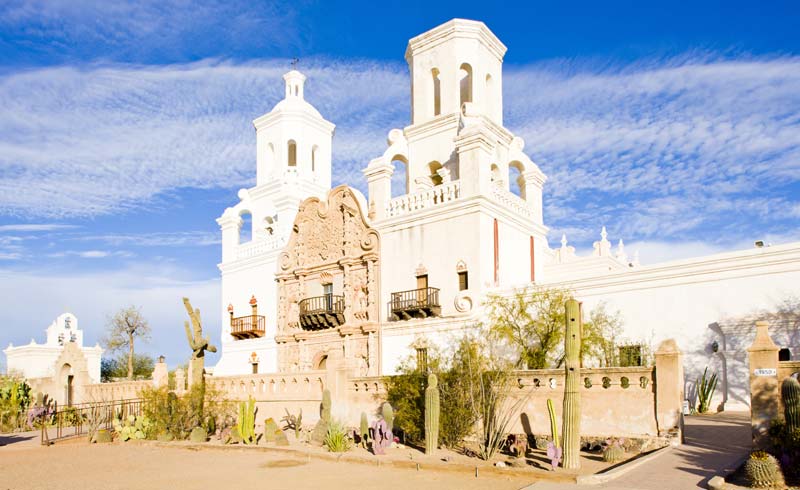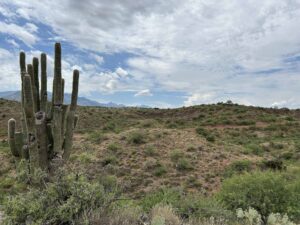Tucson History

Native American History
Long before the arrival of Europeans to the Western United States, Native Americans called the land of Arizona home. Archeologists have found evidence of three major tribal groups in the area–the Anasazi, the Mogollon, and the Hohokam. Southern Arizona’s earliest known inhabitants belonged to the Hohokam tribe of the southern desert. The Hohokam people lived off the land through farming and irrigation for over 700 years. There is no record of the Hohokam people after AD 1400, but they are believed to be the ancestors of the Pima people. In the Pima language, the name Hohokam roughly translates as “those who have vanished.”
In 1687 the Pima and Sobaipuri tribes encountered the Spanish Jesuit missionary Father Eusebio Francisco Kino. Father Kino founded and oversaw the construction of the San Xavier Mission near the Native American village of Bac. In his efforts to introduce Christianity and Spanish culture, he founded approximately 24 missions in the Western United States.
Early Tucson
Tucson’s name comes from the Pima word for “spring at the foot of the black hill,” and although pronounced the same as it is today, it was spelled Stjukshon. The Spanish flag was the first to fly over historic Tucson. In 1776 Spanish settlers built the San Augustin del Tucson presidio to defend themselves from the Apaches. It’s from this settlement that Tucson’s nickname, the “Old Pueblo,” came about. In addition to Christianity and Spanish culture, the Spanish settlers introduced livestock cultivation, a variety of new crops, and different agricultural techniques. Their influence can still be seen in Tucson’s culture and diverse architecture.
In 1821 Mexico won its independence from Spain and Tucson became a part of Mexico. It wasn’t until 1846, during the Mexican War, that the commander of the Mormon Battalion raised the American flag over Tucson. The Treaty of Guadalupe-Hidalgo granted made most of Arizona and New Mexico part of the United States in 1848. Five years, and 30,000 acres later, the Gadsden Purchase solidified the US-Mexico border we know today.
Tucson continued to thrive and change into the culturally rich city that we know today.
Today’s Tucson
Nearly one million people call Tucson and its surrounding areas home. Famous for its rich combination of western and cosmopolitan lifestyles and cultures, Tucson is a unique destination for people from all around the world. The diverse cultural heritage of the area creates a special ambiance unlike any other in the country. There’s a good chance that you’ll hear more than just English on your journeys about town; Spanish, Yaqui, O’odham, German, French, or Dutch are just some of the living languages in town. Climate, commerce, culture,and cutting-edge medical care bring people from all over the world. Tucson is rich in recorded history, and has a diverse population from retirees, to college students, to entrepreneurs. Tucsonans are happy to say that while the city has cosmopolitan perks, it still feels spacious and friendly, like the best of small town America.
Historic Districts and Dwellings
Tucson has a number of historic neighborhoods that create interesting walking tours. The Armory Park Historic District is located west of Stone Avenue between 12th and 19th streets. Developed in the late 1800s by the Southern Pacific Railroad, this residential area features Queen Anne Victorians and a regional style called Anglo Territorial – a blend of Spanish Colonial, Mexican materials and American design features.
South of Cushing Street, between Stone Avenue and the railroad, is the Barrio Historico Historic District (also called Barrio Viejo). More than 150 adobes are located here, and many have been restored. This district is part of the original Barrio Libre, the oldest area of the city. The 100-year-old Cushing Street Bar displays photographs of the old neighborhood.
North of Armory Park is the Pie Allen Neighborhood which is south of 6th Street between Park Avenue and 6th Avenue. This is a residential area named after an apple pie salesman, John Bracket (Pie) Allen, who laid claim to the land, knowing housing would be needed for railroad workers. Anglo Territorial, Sonoran adobe and revival-style homes predominate.
Farther north, south of Speedway Boulevard between Tyndall Avenue and Stone, is the West University Historic District. This is another residential area developed around 1900 with a mix of architectural styles.
The most interesting historic district is El Presidio, south of 6th Street, between Granada and Church avenues. This area was Tucson’s original neighborhood established in 1775 around the Spanish presidio. The Tucson Museum of Art complex and Old Town Artisans are in this district along with other magnificent buildings. The Tucson/Pima County Historical Commission can confirm hours and assist with tours of these districts. (520) 791-4121.


